Scali wrote:That is not an entirely fair comparison. The 8086 dates from 1978. The V20 wasn't released until 1982,
so could take advantage […]
Show full quote
Jo22 wrote:A japanese V20/V30 was much, much better than a stinky 8088 from intel (by comparison; 808x hadn't even got a dedicated unit for
effective address computation. It had to use the ALU for that. 286+ fixed that design flaw).
That is not an entirely fair comparison. The 8086 dates from 1978. The V20 wasn't released until 1982,
so could take advantage of more modern technology, and use more transistors to improve performance
(I wouldn't call it a design flaw, just a result of the limited technology available when the 8086 was designed, a compromise).
The 286 was also introduced in 1982, and was far superior to the V20 and V30 CPUs.
I apologize. 🙁 I really should have had worded it differently. I was rather thinking from a mid-1980s perspective.
I was assuming that the eastern countries weren't bound so much to western standards and could have gone their own way in certain respects
(such as expansion slots, code pages, disk formats, BIOS, memory layout). It wasn't until early 90s when they got a proper MS-DOS (V4.x?), anyway.
Of course they did use DOS software before, but plain CP437 textmode software such as Norton Commander, Turbo Pascal or dBase
(-NC apparently was very popular over there; it was claimed that no russian/eastern DOS user ever saw DOS without NC-)
did run on various DOS compatibles all over the world. Be it something like a Sirius 1, PC-9801,
Robotron 1750, an Apple II with 8086 card or a BBC Master 512 with 80186 board and DOS Plus.
On the other hand, the competitor of the 8086 predcessor (->8080), the Zilog 80, also was from 1970s (~76) but could do more
than the 8080 (~74) or even 8088 in that respect. Unlike the 8080, it was able to perform "single-bit addressing,
shifts/rotates on memory and registers other than the accumulator, rotate instructions for BCD number strings in memory, program looping,
program counter relative jumps, block copy, block input/output (I/O), and byte search instructions." (source)
Edit: Never mind, I didn't mean to criticize the 8086/88 in first place. I rather wondered why they tried so badly to copy western tech,
when they got better CPU designs in their own countries or their nearest neighborhood (for example, a NEC µPD7220 was much
more sophisticated than the Motorola 6845). That's why I would like to hear some interviews with ex-developers of these countries.
It would be interesting to hear who had the idea to built that Junior XT with 16-Bit slots, for example.
And which background story was related to that (which application needed the extra memory performance, etc.)
"Time, it seems, doesn't flow. For some it's fast, for some it's slow.
In what to one race is no time at all, another race can rise and fall..." - The Minstrel
//My video channel//
